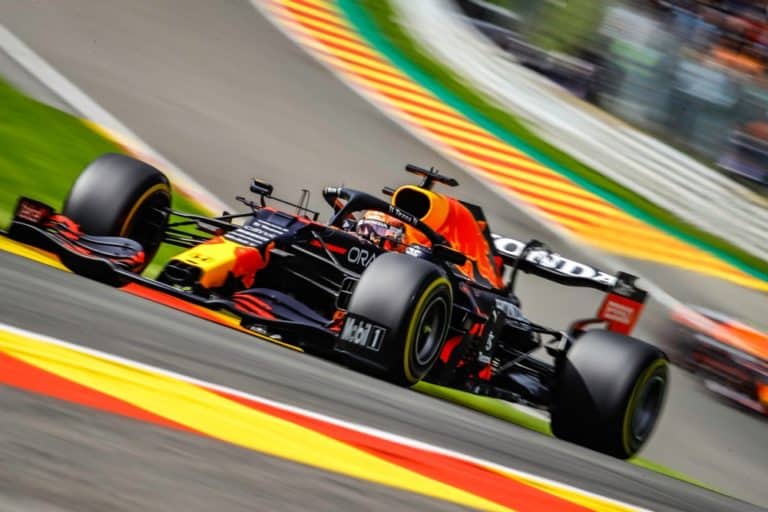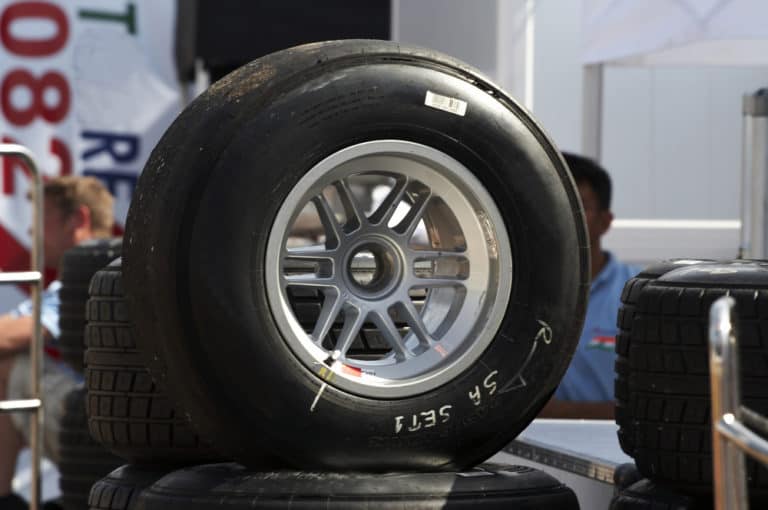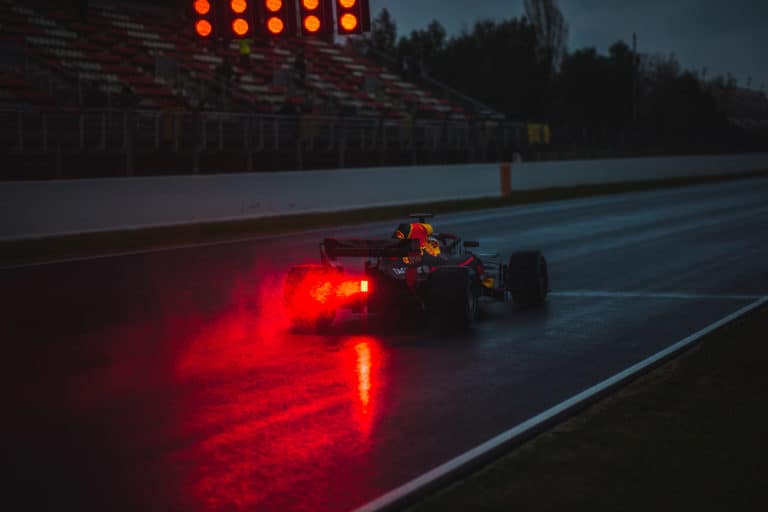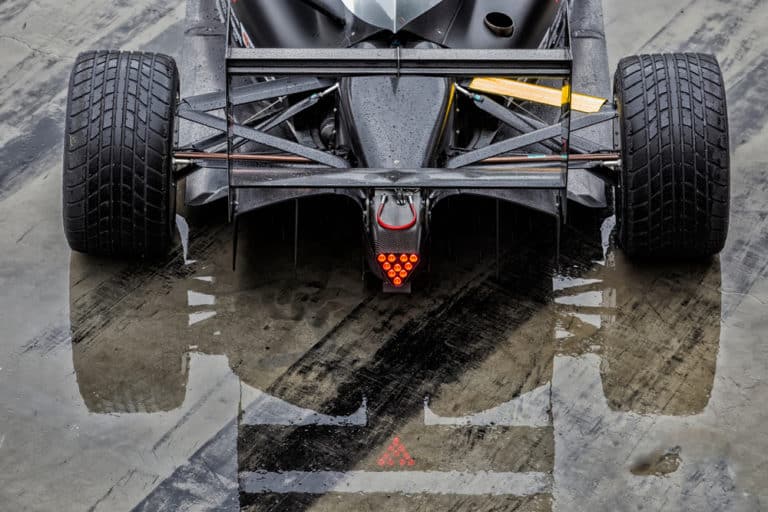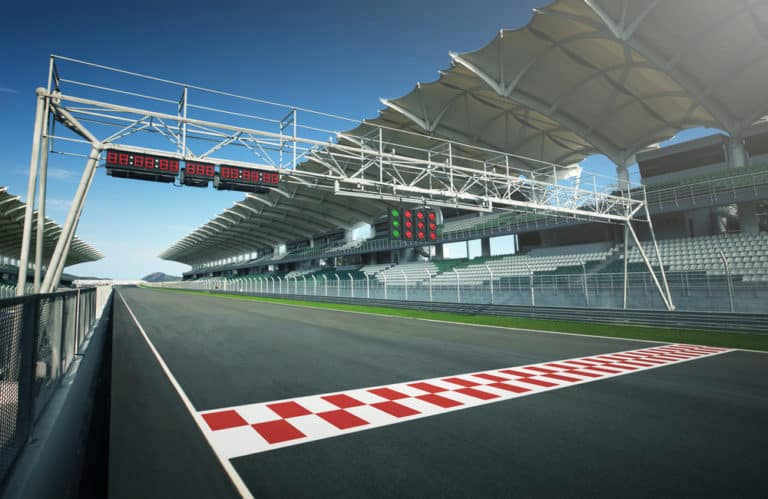Editorial credit: Ev. Safronov / Shutterstock.com
It’s race day; you’ve waited a whole week to watch another F1 race, and just as your favorite driver is making headway on the track, their tires lock up. As a result, not only have they lost a bit of time, but they’ve become vulnerable to being overtaken by the opposition. You’ve probably seen this happen while watching a race and wondered why F1 tires lock up.
Tires lock up in F1 when too much force is on the brakes. Too much pressure on the brakes causes the disc to rotate slower than the car is moving or stop altogether. As a result, the tire rubs across the track’s surface, and sometimes the tires lock up, creating white smoke.
It takes great skill and precision to be an F1 driver, and sometimes when under pressure, it just takes one mistake to lose the winning advantage in the race. Using the brakes effectively is just as important as understanding how to drive the rest of an F1 car. Tires locking up is common, and even the best drivers lock up occasionally.
If you’re looking for some F1 merchandise, check out the awesome stuff at the official F1 store here.
Why Do F1 Tires Lock Up?
Tire lock-up happens on F1 cars because F1 cars do not have anti-lock brakes. Without anti-lock brakes, the car is much more challenging to steer and slow down. In addition, locking tires in F1 can lead to damaged tires and damage to the car if the lock-up causes the car to go off track and into the wall or hit another car.
F1 cars are designed to be driven based on the driver’s skill. They do not have the same systems as road cars. There has been a significant decrease in lock-ups as f1 cars are becoming more advanced, and the downforce plays a substantial role in helping slow down an f1 car.
F1 cars also have energy braking in the rear, which should help reduce lock-ups. Locking up in F1 means the wheels on the car stop rotating, and the tires are sliding across the track. So the best way drivers can avoid lock-ups is by braking with less pressure.
Drivers can choose where they want their brake pressure split in their car. For example, some drivers prefer more pressure on the rear brakes, as this better suits their driving style, while others may prefer more in the front.
What Happens When F1 Tires Lock Up?
When the tires of an f1 car lock up, the tires slide, which slows the car down. Road cars have ABS brakes, this allows the car to stop, and when brakes are applied in a road car, you are likely to be flung forward.
Brakes in the front of a car are usually more powerful than brakes at the back because the front brakes need to work harder to lower the car down. On the other hand, the rear brakes have much less work to do as most of the weight is focused on the front.
F1 cars have big carbon brakes that have remarkable power to stop an f1 car from traveling at high speeds. The only problem with the design of these brakes is that the f1 car can also transfer weight from side to side. This means when an f1 driver isn’t careful with steering and goes roughly through a corner, the car’s weight can go in the opposite direction.
Locking up is not just limited to flat areas on the track but can happen over bumps too. When locking up happens over bump areas, this is known as “under rotation.” Under rotation is when one wheel rotates less than the other three, this results in the tire having a very flat spot. When the tire has a flat spot, it leaves the car vulnerable to vibrations and more lock-ups.
What Causes An F1 Driver’s Tires To Lock Up?
The most common reasons why F1 tires lock up is because too much pressure is applied to the brakes or the tires are too cold and don’t have enough grip. In addition, most f1 drivers who aim for excellent lap times brake as late as possible; if the timing isn’t right, they can lock up.
Braking At The Right Time
F1 drivers also need to know the track well and know when it’s the perfect time to brake. F1 drivers need to go from accelerating to braking in less than half a second, so it’s easy to understand why locking up is possible.
The lack of ABS brakes means the car does not automatically release brake pressure when the wheels lock up.
Braking too late is the most common reason F1 cars lock up. Drivers try to brake at the perfect time, but sometimes they brake too late, and their tires lock up. If they brake too late, they also need to put more pressure on them to slow the car down, resulting in a lock-up.
Race Day Track Conditions
Track conditions impact the amount of grip the tires have. Lock-ups are more prevalent when it rains and the wet track conditions. The painted lines on the track offer little grip for the f1 tires, and when a driver touches these lines while driving in wet conditions, they can lock up.
Worn Tires
When F1 tires become worn, they are more likely to lock up because they have less grip. If a driver’s tires have less grip, they need to adjust where they brake and the amount of pressure applied to the brakes to avoid locking up.
How Are Tires Affected When There Is A Lock Up?
Lock-ups can cause a driver to lose their current position in the race, cause the driver to go off track, and severely affect a driver’s lap times. The worst part about locking up is its effect on the tires. When a driver locks up, the wheels stop rotating and get damaged by the friction caused by the tires sliding across the race track. As a result, the tires are no longer round but have flat spots.
F1 tires are also prone to heating up very quickly, and when they overheat, they start to lose grip. As a result, there is more tire degradation and more lock-ups.

Conclusion
F1 drivers are highly skilled, and part of mastering an F1 car is knowing when to brake. The most common reason tires lock up in F1 is because there is too much pressure applied to the brakes, and unlike road cars, F1 cars lack ABS braking systems. Braking points change as the race progresses, and finding the perfect time to brake can be challenging for any experienced F1 driver.

